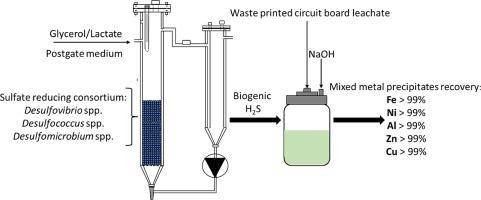当前位置:
X-MOL 学术
›
Hydrometallurgy
›
论文详情
Our official English website, www.x-mol.net, welcomes your
feedback! (Note: you will need to create a separate account there.)
Base metals recovery from waste printed circuit board leachate using biogenic hydrogen sulfide gas
Hydrometallurgy ( IF 4.8 ) Pub Date : 2024-05-29 , DOI: 10.1016/j.hydromet.2024.106341 Jonovan Van Yken , Naomi J. Boxall , Ka Yu Cheng , Aleksandar N. Nikoloski , Navid R. Moheimani , Anna H. Kaksonen
Hydrometallurgy ( IF 4.8 ) Pub Date : 2024-05-29 , DOI: 10.1016/j.hydromet.2024.106341 Jonovan Van Yken , Naomi J. Boxall , Ka Yu Cheng , Aleksandar N. Nikoloski , Navid R. Moheimani , Anna H. Kaksonen

|
Electronic waste, or e-waste, represents one of the rapidly expanding categories of waste worldwide. By 2019, the global production of e-waste had surged to 53.6 million tons. Due to its substantial metal content, e-waste holds significant financial value, estimated at US$57 billion globally in 2019, predominantly concentrated in printed circuit boards (PCBs). Previous studies have explored hydrometallurgy techniques to extract base metals from PCBs, but effectively recovering these solubilised metals remained a challenge. This research sought to assess metal recovery from PCB waste leachate by utilising hydrogen sulfide generated through a consortium of sulfate-reducing bacteria (SRB) in a fluidised bed reactor (FBR). Both lactate and glycerol were examined as potential organic electron donors for the sulfate reduction. With lactate (1 g L) as the electron donor, the FBR achieved an average sulfate reduction efficiency of 62%, with a hydrogen sulfide (HS) production rate of 250 mg HS-S L d and HS-S concentration of 300 mg L in the effluent. When glycerol was the organic electron donor, the average sulfate reduction efficiency was 49%, HS production rate was 210 mg HS-S L d and HS-S concentration was 260 mg L. , and were the dominant sulfate reducers in the FBR. The resulting dissolved hydrogen sulfide was employed to recover metals from e-waste leach liquor. Utilising biogenic sulfide and NaOH, a notably high precipitation efficiency (>99%) was attained for aluminum, nickel, copper, and zinc. Additionally, iron, utilised in the e-waste leaching process, was also recovered with an efficiency exceeding 99%. The precipitation of metals occurred within a pH range from 1.5 to 8.5. Overall, this process facilitated the formation of valuable mixed-metal precipitates from waste PCB-derived leachate. These precipitates could undergo further purification or serve as raw material for subsequent processes.
中文翻译:

利用生物硫化氢气体从废弃印刷电路板渗滤液中回收贱金属
电子废物是全球范围内迅速扩大的废物类别之一。到2019年,全球电子垃圾产量已激增至5360万吨。由于金属含量高,电子垃圾具有巨大的经济价值,2019 年全球价值估计为 570 亿美元,主要集中在印刷电路板 (PCB) 中。先前的研究已经探索了从多氯联苯中提取贱金属的湿法冶金技术,但有效回收这些溶解的金属仍然是一个挑战。本研究试图利用流化床反应器 (FBR) 中硫酸盐还原菌 (SRB) 菌群产生的硫化氢来评估 PCB 废物渗滤液中的金属回收率。乳酸和甘油都被检查为硫酸盐还原的潜在有机电子供体。以乳酸(1 g·L)为电子供体,FBR平均硫酸盐还原效率为62%,硫化氢(HS)生成率为250 mg HS-S·L·d,HS-S浓度为300 mg·L·d在废水中。当甘油为有机电子供体时,平均硫酸盐还原效率为49%,HS生成率为210 mg HS-S·L·d,HS-S浓度为260 mg·L·d,是FBR中的主要硫酸盐还原剂。所得溶解的硫化氢用于从电子废物浸出液中回收金属。利用生物硫化物和 NaOH,对铝、镍、铜和锌实现了极高的沉淀效率 (>99%)。此外,电子垃圾浸出过程中使用的铁也被回收,效率超过 99%。金属沉淀发生在pH值1.5至8.5范围内。 总体而言,该过程促进了废 PCB 浸出液中有价值的混合金属沉淀物的形成。这些沉淀物可以进行进一步纯化或作为后续工艺的原材料。
更新日期:2024-05-29
中文翻译:

利用生物硫化氢气体从废弃印刷电路板渗滤液中回收贱金属
电子废物是全球范围内迅速扩大的废物类别之一。到2019年,全球电子垃圾产量已激增至5360万吨。由于金属含量高,电子垃圾具有巨大的经济价值,2019 年全球价值估计为 570 亿美元,主要集中在印刷电路板 (PCB) 中。先前的研究已经探索了从多氯联苯中提取贱金属的湿法冶金技术,但有效回收这些溶解的金属仍然是一个挑战。本研究试图利用流化床反应器 (FBR) 中硫酸盐还原菌 (SRB) 菌群产生的硫化氢来评估 PCB 废物渗滤液中的金属回收率。乳酸和甘油都被检查为硫酸盐还原的潜在有机电子供体。以乳酸(1 g·L)为电子供体,FBR平均硫酸盐还原效率为62%,硫化氢(HS)生成率为250 mg HS-S·L·d,HS-S浓度为300 mg·L·d在废水中。当甘油为有机电子供体时,平均硫酸盐还原效率为49%,HS生成率为210 mg HS-S·L·d,HS-S浓度为260 mg·L·d,是FBR中的主要硫酸盐还原剂。所得溶解的硫化氢用于从电子废物浸出液中回收金属。利用生物硫化物和 NaOH,对铝、镍、铜和锌实现了极高的沉淀效率 (>99%)。此外,电子垃圾浸出过程中使用的铁也被回收,效率超过 99%。金属沉淀发生在pH值1.5至8.5范围内。 总体而言,该过程促进了废 PCB 浸出液中有价值的混合金属沉淀物的形成。这些沉淀物可以进行进一步纯化或作为后续工艺的原材料。


















































 京公网安备 11010802027423号
京公网安备 11010802027423号